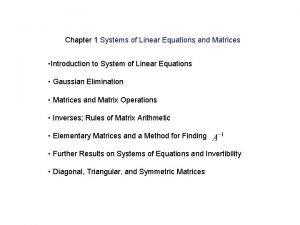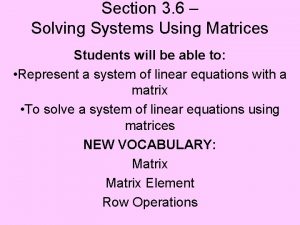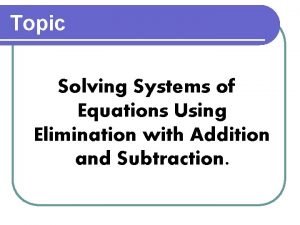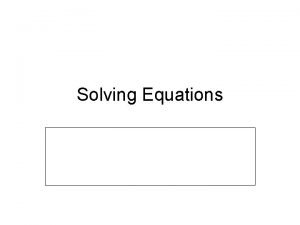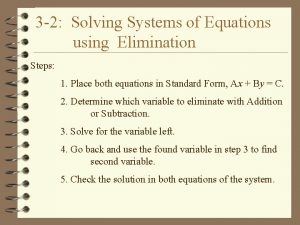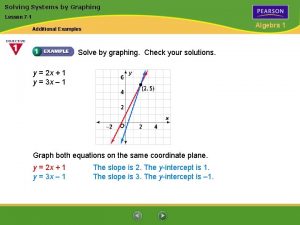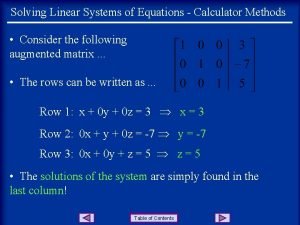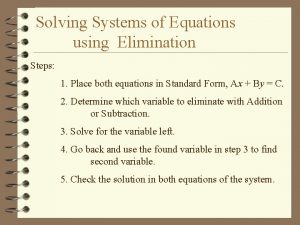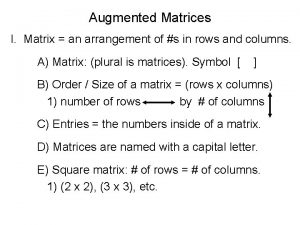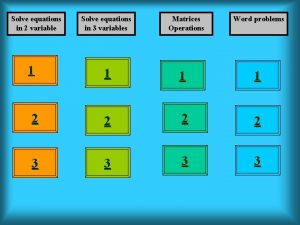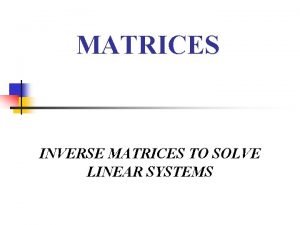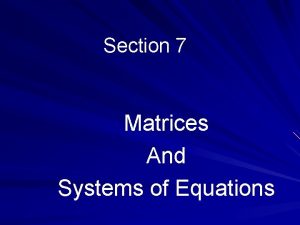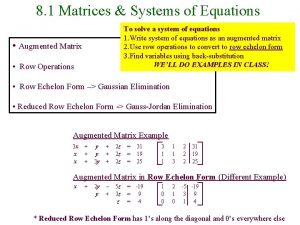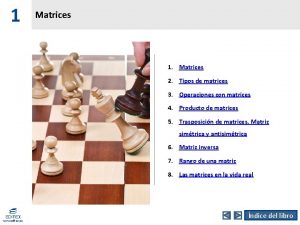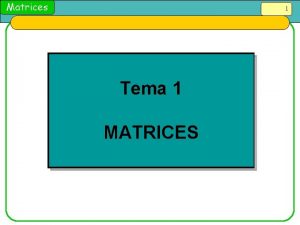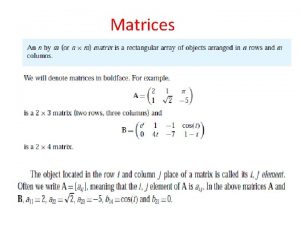MATRICES Using matrices to solve Systems of Equations
















- Slides: 16

MATRICES Using matrices to solve Systems of Equations

Solving Systems with Matrices We can use matrices to solve systems that involve 2 x 2 (2 equations, 2 variables) and 3 x 3 (3 equations, 3 variables) systems. We will look at two methods: • Cramer’s Rule (uses determinants) • Matrix Equations (uses inverse matrices)

Cramer’s Rule - 2 x 2 n n Cramer’s Rule relies on determinants Consider the system below with variables x and y:

Cramer’s Rule - 2 x 2 n The formulae for the values of x and y are shown below. The numbers inside the determinants are the coefficients and constants from the equations.

Cramer’s Rule - 3 x 3 n Consider the 3 equation system below with variables x, y and z:

Cramer’s Rule - 3 x 3 n The formulae for the values of x, y and z are shown below. Notice that all three have the same denominator.

Cramer’s Rule n n Not all systems have a definite solution. If the determinant of the coefficient matrix is zero, a solution cannot be found using Cramer’s Rule because of division by zero. When the solution cannot be determined, one of two conditions exists: n n The planes graphed by each equation are parallel and there are no solutions. The three planes share one line (like three pages of a book share the same spine) or represent the same plane, in which case there are infinite solutions.

Cramer’s Rule n Example: 3 x - 2 y + z = 9 Solve the system x + 2 y - 2 z = -5 x + y - 4 z = -2

Cramer’s Rule 3 x - 2 y + z = 9 x + 2 y - 2 z = -5 x + y - 4 z = -2 The solution is (1, -3, 0)

Matrix Equations n Step 1: Write the system as a matrix equation. A three equation system is shown below.

Matrix Equations n n Step 2: Find the inverse of the coefficient matrix. This can be done by hand for a 2 x 2 matrix; most graphing calculators can find the inverse of a larger matrix.

Matrix Equations n Step 3: Multiply both sides of the matrix equation by the inverse. The inverse of the coefficient matrix times the coefficient matrix equals the identity matrix. Note: The multiplication order on the right side is very important. We cannot multiply a 3 x 1 times a 3 x 3 matrix!

Matrix Equations n Example: Solve the system 3 x - 2 y = 9 x + 2 y = -5

Matrix Equations Multiply the matrices (a ‘ 2 x 2’ times a ‘ 2 x 1’) first, then distribute the scalar.

Matrix Equations n Example #2: Solve the 3 x 3 system 3 x - 2 y + z = 9 x + 2 y - 2 z = -5 x + y - 4 z = -2 Using a graphing calculator:

Matrix Equations
 Systems of linear equations matrices
Systems of linear equations matrices 3-6 solving systems using matrices
3-6 solving systems using matrices Solve a system of equations using elimination
Solve a system of equations using elimination Inverse operations example
Inverse operations example Solve a system of equations using elimination
Solve a system of equations using elimination Elimination by addition and subtraction
Elimination by addition and subtraction Factoring quadratics with generic rectangles
Factoring quadratics with generic rectangles Lesson 7 solve systems of equations by graphing
Lesson 7 solve systems of equations by graphing Solving multi step equations calculator
Solving multi step equations calculator Three ways to solve systems of equations
Three ways to solve systems of equations Solving systems of equations by elimination steps
Solving systems of equations by elimination steps How to do matrices on ti 84
How to do matrices on ti 84 Solving word problems using systems of equations
Solving word problems using systems of equations Equations to matrix
Equations to matrix Matrices simultaneous equations worksheet
Matrices simultaneous equations worksheet Transformations using matrices
Transformations using matrices Symmetric relation
Symmetric relation
